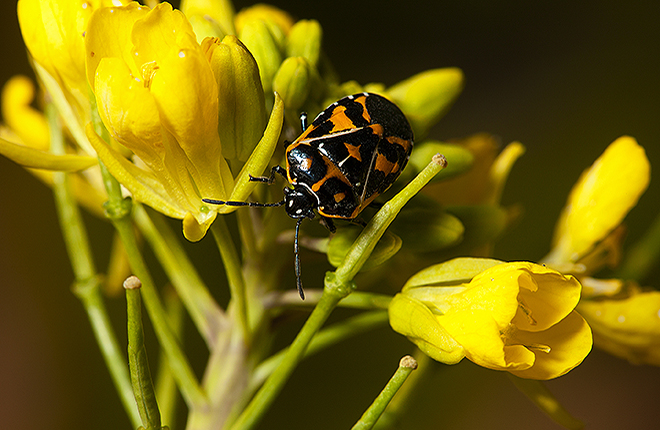Clown-Colored Harlequin Bugs Are No Joke
Don’t let the harlequin bug’s red and black clown suit fool you. There is nothing funny about the way this pest can destroy a whole field of broccoli, Brussels sprouts, kale, cauliflower, horseradish, or other vegetables popular with urban gardeners and organic growers. Now there may be hope for a new control, thanks to the work of the Agricultural Research Service’s (ARS) Invasive Insect Biocontrol and Behavior Laboratory in Beltsville, Maryland.
Harlequin bugs are becoming a bigger problem every summer in the Southeast and in the Mid-Atlantic, due to increased urban vegetable gardening and organic farming in the past 5 years.
Add mild winters and decreasing broad-spectrum insecticide use to the mix, and you get exploding harlequin bug populations.
Picking the bugs off young crops by hand—the standard control method for home gardeners and organic farmers—simply cannot keep up; nor has the newer tactic of planting mustard as a “trap crop” so far proved effective enough. (A trap crop is grown to provide a low-value alternative to lure pests away from a high-value crop.)
So in hopes of supercharging harlequin bug control, ARS researchers Don Weber and Ashot Khrimian with the Beltsville lab have been working on a synthetic version of the insect’s own aggregation pheromone to use as a lure, either to trap them directly or to make trap crops work better. Pheromones are chemicals that trigger social responses in others of the same species. In this case, when a male harlequin bug finds food, he releases an aggregation pheromone to alert others to aggregate, or gather, and feast—like ringing the dinner bell.
In 2008, University of California-Riverside researchers figured out the chemical structure of the bug’s aggregation pheromone and named it “murgantiol.” But they didn’t describe the three-dimensional (3-D) arrangement of the chemical components—a property called “stereochemistry.” Murgantiol’s chemical formula has the potential for 16 different 3-D forms, known as “stereoisomers.”
Stereoisomers with the same chemical formula but different 3-D structures can have different, even opposite, biological activities; one arrangement may be an attractant, while another shape may be a repellent.
Khrimian and Weber determined that just two forms make up the harlequin bug’s pheromone and that having other stereoisomers in the mix does not lower the pheromone’s attractiveness as a lure—an important point to potential manufacturers.
“Not needing to make the lure of one or two pure components, synthetic or natural, is going to make it faster and much less expensive to manufacture, making it more feasible to produce commercially,” Khrimian says.
When Weber tested a synthetic version of the pheromone on collard plants under conditions similar to farm fields, harlequin bugs—old and young, male and female—came running and flying from many yards away.
“It worked almost perfectly as a lure,” Weber explains. “The problem is many of the insects did not stay with the lure-baited plants; some would eat, mate, and then fly off, potentially from the trap crop into a farmer’s high-value crop—if this had actually been a farmer’s field.”
To prevent such eat-and-run escapes, Weber is now working with researchers at Virginia Tech, testing a variety of baited trap designs that could put the harlequin bugs permanently out of circulation. Given the sheer numbers that can invade a field, the traps will need to capture bugs efficiently and require little attention from growers to empty and reset.
“An effective trap will reduce losses from this significant vegetable pest, but only if we can do it in a way that minimizes growers’ time and worry and pesticide use,” Weber says.—By J. Kim Kaplan, ARS Office of Communications.
“Clown-Colored Harlequin Bugs Are No Joke” was published in the August 2016 issue of AgResearch Magazine.
Key Facts
- Harlequin bugs are a growing pest problem, especially in the Mid-Atlantic.
- They eat many key crops, like broccoli, cauliflower, and kale.
- The bug’s own pheromones are being turned against it as a control measure.
Full Story








